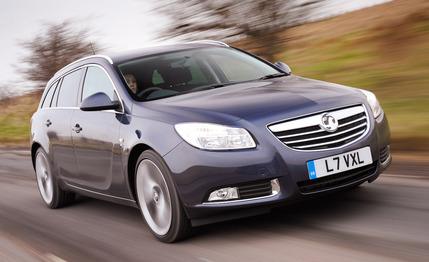
 First Drive Review
First Drive Review
Not so long ago, before General Motors’ world turned upside down, there was a plan to bring the Opel Insignia—which is branded as a Vauxhall in the U.K.—to the U.S. as a Saturn. Then GM sold Saturn to Roger Penske, and that plan died. However, the Insignia sedan will come to the U.S. as the 2011 Buick Regal. It won’t be offered with this engine or in a wagon style—at least initially—but we expect the interior, styling, and personality to carry over nearly unchanged.


The Insignia is already relevant to this market, however, because the updated Epsilon component set that underpins it also forms the bones of the new Buick LaCrosse and will be seen in the next-generation Chevrolet Malibu. And our Sports Tourer 1.6T tester’s turbocharged 1.6-liter Ecotec four-cylinder, which seems awfully small for a car of this size, is hugely significant because all automakers are going to have to downsize their engines to meet impending government fuel-economy standards and CO2 emissions regulations. When the Chevrolet Cruze goes on sale next year, it will be outfitted with a turbocharged 1.4-liter Ecotec four, and we expect many of the General’s V-6 engines to be replaced by turbo fours as well.
Downsize and Pressurize
GM offers two turbocharged four-cylinder Ecotecs in the Insignia: this 177-hp 1.6-liter and a 2.0-liter that produces 217 hp. The smaller engine makes 170 lb-ft of torque from 2200 to 5500 rpm. GM claims the 1.6T carries this car from 0 to 60 mph in 8.7 seconds—nearly three seconds quicker than the naturally aspirated 138-hp, 1.8-liter four available in the same vehicle—while achieving equal fuel consumption and creating slightly fewer CO2 emissions.
We averaged about 24 mpg while flogging the car pretty hard; that’s close to its city fuel-economy rating in Europe and on par with the last four-cylinder Chevrolet Malibu we tested, a car that produced similar performance numbers with eight fewer horses. Although the fuel economy isn’t bad, it adds to our impression that smaller turbo engines don’t actually live up to the hype that they give the same performance as larger engines while producing way better gas mileage. In practice, the engine doesn’t feel overmatched to the car. It pulls well, but it comes on strong higher up the rev range than the 2200-rpm peak-torque figure suggests and runs out of steam rather quickly. It’s smooth until you get the tach needle around the 5000-rpm mark.
Aspirational in Price Alone
The rest of the car is quite impressive. Inside, it’s well styled and nicely made, with a much richer mix of materials than U.S. buyers of mid-size sedans are used to. The fastback styling looks terrific, and the liftgate cleverly incorporates the bumpers and taillights to give a really wide load area. The design impinges on the cargo room, however, which is relatively tight at 19 cubic feet with the rear seats up (54 cubes with the seats down), about the same as in a Subaru Impreza five-door or Infiniti EX35.
On the road, the Insignia gives a clue to how the next-generation Malibu and the 2011 Buick Regal will drive. In short, it’s good but not class-leading. The steering, for instance, is overly aggressive on turn-in and lacks the reassurance that comes with a truly linear rack. The handling is safe but lacks involvement, and the ride quality is average, despite the presence on gasoline-engined models of a real-time adaptive shock system that GM dubs FlexRide. This has standard, sport, and touring settings. The latter softens the suspension. Sport mode stiffens the shocks, gives a swifter throttle response, changes the valving in the variable-effort steering, and, in all-wheel-drive models, shifts more torque to the rear wheels. A driver can customize the sport settings through the infotainment system to change steering weight, shock control, and even switch off the all-wheel drive.
The Elite model we drove costs nearly $37,000, with options, in the U.K., even after you take off that country’s 15-percent value-added tax. We’d say this wagon would make a perfect Buick, but GM will have to work out a way of making it less expensive for the U.S. market.